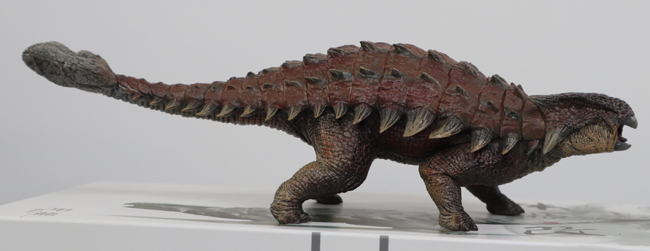New Ankylosaur Genus Named and Described – Tatankacephalus
A husband and wife team of palaeontologists, have found a new species of armoured dinosaur, an ankylosaur, that may represent a link between primitive thyreophorans and more advanced members of this dinosaur group.
Armoured Dinosaur
This heavily armoured beastie, perhaps with a characteristic ankylosaur tail-club swishing to and fro, inhabited what is now Montana in the United States approximately 112 million years ago (Aptian/Albian faunal stages). Although entirely herbivorous this “walking tank” would have been a very formidable looking animal, covered in bony armour and scutes, perhaps exceeding 7 metres in length and weighing 2,500 kilogrammes or more.
The husband and wife team of Bill and Kris Parsons research associates at the Buffalo Museum of Science in New York, on a expedition to Montana in 1997 spotted part of the dinosaur’s skull eroding out of rock on a hillside. Over the next few years they kept returning to this location and excavating the site. To date they have retrieved almost all of the skull, scutes (amour plating), ribs, vertebra and other bone fragments that may represent part of a limb bone.
The skull material is particularly important, permitting scientist to study this new find in relation to other known ankylosaur genera. The findings have been published in the Canadian scientific publication the “Journal of Earth Sciences”. The remains have been declared a holotype for a new genus of armoured dinosaur Tatankacephalus cooneyorum. The name has been derived from the local Indian name for bison and the Greek for head. The specific element of the name honours the family John Patrick Cooney, an important name in 19th century New York business circles.
A Replica of a Typical Armoured Dinosaur (Anklyosauridae)

The heavily armoured Ankylosaurus replica from Nanmu Studio (Mace Red). A replica of an iconic armoured dinosaur. Picture credit: Everything Dinosaur.
Picture credit: Everything Dinosaur
The picture shows a typical ankylosaur from the Nanmu Studio Jurassic Series range: Nanmu Studio Jurassic Series Dinosaur Models.
The armour on the backs, tails and flanks of these dinosaurs was made from keratin, the same protein that makes up the beaks of birds and shells of chelonians.
Tatankacephalus cooneyorum
Commenting on the unveiling of the new dinosaur, Bill Parsons stated:
“They [ankylosaurs] were big dinosaur versions of a Sherman tank. They were armoured and they withstood whatever came at them, and they just kept going”.
Analysis of the skull indicates the extent of this animal’s protection, with two sets of horns positioned behind the eye and two thick domes at the back of the skull and thickened areas around the top of the snout and nasal area.
To stay safe from the bigger brutes around, the ankylosaur may have flattened its body on the ground and pulled in its head, where head horns could protect the animal from a nasty neck bite, whilst also protecting its flank, Parsons said. The dinosaur has been beautifully illustrated by Bill Parson who is an experienced scientific illustrator.
The well-preserved skull indicates that this particular dinosaur represents a transition from primitive ankylosaurs to more advanced, later ones. Late Cretaceous ankylosaurs had much larger horns on the sides of the cheek and a nasal and snout area that was highly curved. The nasal passages themselves were complicated, perhaps indicating that these animals had a highly developed sense of smell. It has even been suggested that these complex nasal passages may have helped remove moisture from the exhaled breath of these beasts, perhaps an important evolutionary adaptation if these animals lived in dry, arid areas. In contrast with later examples, T. cooneyorum has small horns and only a slightly curved nose.
Commentating on the new ankylosaur, Professor Lawrence Witmer of Ohio University stated:
“For years, Bill and Kris have been collecting fossils from a critical time in Earth’s history and their hard work has paid off. This is a really important find and gives us a clearer view of the evolution of the armoured dinosaurs”.






Leave A Comment